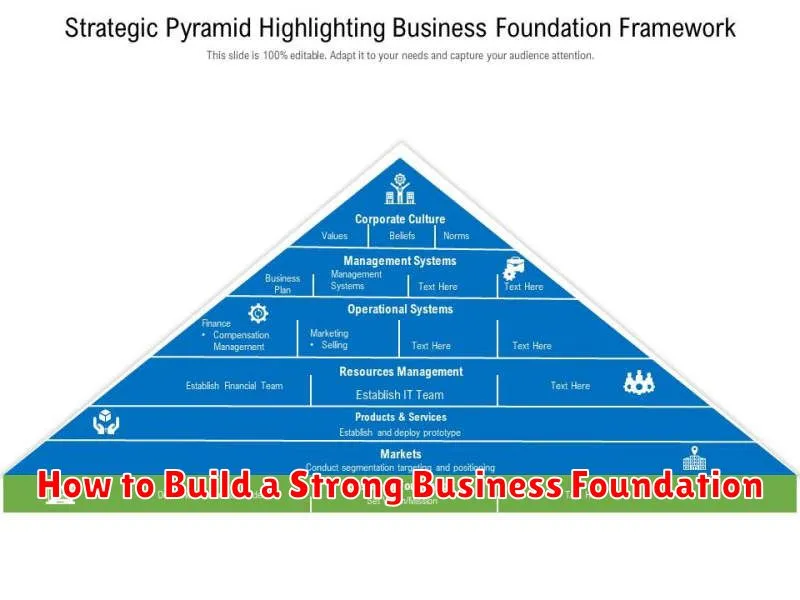Are you dreaming of owning a thriving small business? Running a successful enterprise requires more than just a great idea; it demands a strategic approach. This article explores proven strategies to help you navigate the challenges and unlock the potential of your small business. Discover effective techniques for marketing, financial management, customer service, and business growth, empowering you to build a sustainable and profitable venture. Learn how to develop a robust business plan, manage your cash flow, and attract and retain loyal customers. Unlock the secrets to success and turn your small business dreams into reality.
How to Build a Strong Business Foundation

Building a strong business foundation is crucial for long-term success. This involves several key elements that should be addressed from the outset.
First, develop a solid business plan. This document should outline your business goals, target market, competitive analysis, marketing strategy, and financial projections. A well-structured plan provides a roadmap for your business and attracts potential investors.
Next, secure adequate funding. Explore various options including personal savings, loans, grants, or investors. Careful financial management is essential to ensure your business has the resources it needs to thrive.
Establish a robust legal structure. This might involve registering your business as a sole proprietorship, partnership, LLC, or corporation. Choosing the right structure protects your personal assets and affects your tax liabilities.
Furthermore, build a strong brand identity. This includes creating a memorable logo, defining your brand values, and consistently communicating your brand message across all platforms. A strong brand builds recognition and customer loyalty.
Finally, focus on building a skilled and motivated team. Hire individuals who share your vision and possess the necessary skills to contribute to your business’s success. Investing in employee training and development fosters a positive and productive work environment.
Creating a Business Plan That Works
A well-crafted business plan is crucial for the success of any small business. It serves as a roadmap, guiding your actions and helping you secure funding. A strong plan outlines your business goals, target market, and financial projections.
Begin by defining your business idea clearly. This includes identifying a unique selling proposition (USP) that sets you apart from competitors. Thoroughly research your target market to understand their needs and preferences. This research will inform your marketing strategy and product development.
Develop realistic financial projections, including startup costs, operating expenses, and revenue forecasts. This section should demonstrate the financial viability of your business and your ability to manage finances effectively. Secure necessary funding through loans, investors, or personal savings, aligning with your financial projections.
Regularly review and update your business plan. The business environment is dynamic; adapting your plan to reflect market changes and your own progress is vital for long-term success. This ensures your business remains agile and responsive to opportunities and challenges.
Consider seeking advice from a business mentor or consultant. Their expertise can provide valuable insights and help you refine your plan and strategies. Remember, a flexible and well-researched business plan is a living document that supports your journey towards a thriving small business.
Effective Time and Resource Management
Effective time and resource management is crucial for small business success. It ensures tasks are completed efficiently, maximizing productivity and minimizing waste.
Prioritize tasks using methods like the Eisenhower Matrix (urgent/important), focusing on high-impact activities first. Utilize project management tools to track progress, deadlines, and resource allocation.
Delegate tasks effectively to free up your time for strategic initiatives. Clearly define roles and responsibilities, providing adequate training and support.
Regularly review your processes, identifying areas for improvement and streamlining workflows to eliminate redundancies and bottlenecks. Embrace automation where possible to enhance efficiency.
Careful budgeting and financial tracking are essential components of resource management. Monitor expenses, control costs, and allocate funds strategically to support growth and profitability.
Finally, regular self-assessment is key. Reflect on your time management strategies and resource allocation, adjusting your approach as needed to optimize performance and achieve your business goals.
Marketing on a Budget for Small Businesses

Effective marketing doesn’t require a large budget. Small businesses can leverage cost-effective strategies to reach their target audience.
Social media marketing is a powerful tool. Platforms like Facebook, Instagram, and Twitter offer free organic reach and affordable advertising options. Focus on creating engaging content and interacting with your followers.
Email marketing remains highly effective. Build an email list by offering valuable content in exchange for email addresses. Regular newsletters and targeted promotions can nurture leads and drive sales.
Content marketing is crucial. Create valuable, informative content – blog posts, articles, videos – that showcases your expertise and attracts potential customers. Optimize your content for search engines (SEO) to improve organic visibility.
Local SEO is essential for brick-and-mortar businesses. Ensure your business is listed accurately on Google My Business and other relevant online directories. Encourage customer reviews to boost your online reputation.
Networking is invaluable. Attend industry events, join local business groups, and collaborate with complementary businesses to expand your reach and build relationships.
Leverage free resources. Explore free design tools, utilize free stock photos, and take advantage of free online marketing resources to minimize costs.
By strategically employing these budget-friendly marketing tactics, small businesses can effectively build brand awareness, generate leads, and drive sales without breaking the bank.
How to Build Customer Loyalty and Trust
Building customer loyalty and trust is crucial for the success of any small business. It’s more cost-effective to retain existing customers than to constantly acquire new ones. Focus on providing exceptional customer service; promptly addressing concerns and exceeding expectations fosters positive relationships.
Transparency is key. Be open and honest with your customers about your products, services, and business practices. This builds trust and reduces the likelihood of misunderstandings or negative surprises. Consider using clear and concise communication in all your interactions.
Implement a loyalty program to reward repeat business. Offering discounts, exclusive access, or special perks can significantly enhance customer loyalty. Personalized communication, such as tailored email marketing or birthday greetings, can also strengthen customer relationships.
Actively seek customer feedback. Regularly solicit reviews and comments to understand your customers’ needs and identify areas for improvement. Responding to feedback shows you value your customers’ opinions and are committed to meeting their needs. This demonstrates commitment to continuous improvement, further solidifying trust.
Finally, maintain a consistent brand experience across all touchpoints. Ensure your messaging, customer service, and product quality are consistently high, regardless of the channel through which customers interact with your business. This builds brand recognition and reliability, which are essential for long-term customer loyalty.
The Importance of Consistent Branding

Consistent branding is critical for the success of any small business. It builds recognition and trust with your target audience. A unified brand message across all platforms—website, social media, marketing materials—creates a cohesive and professional image.
Consistency in your logo, color palette, fonts, and voice ensures that your brand is easily identifiable and memorable. This memorability translates into increased customer loyalty and repeat business. A strong, consistent brand differentiates you from competitors and positions your business as a reliable and high-quality option.
Investing in consistent branding is an investment in your long-term success. It’s a foundational element for building a strong brand reputation and ultimately driving sustainable growth for your small business.
Managing Finances and Cash Flow Wisely
Effective financial management is crucial for small business success. Maintaining healthy cash flow is paramount; this requires careful tracking of income and expenses, accurate forecasting, and proactive budgeting.
Accurate accounting is essential. Utilize accounting software or hire a bookkeeper to maintain detailed records of all transactions. Regularly review your financial statements – profit and loss, balance sheet, and cash flow statement – to identify areas for improvement and potential problems.
Strategic budgeting helps control spending and allocate resources effectively. Create realistic budgets, projecting both income and expenses. Regularly compare actual performance against the budget and adjust as needed.
Managing receivables efficiently is key to consistent cash flow. Establish clear payment terms with clients and follow up promptly on outstanding invoices. Consider offering incentives for early payment.
Controlling payables involves negotiating favorable payment terms with suppliers and paying invoices on time to maintain good credit standing. Explore options such as early payment discounts to improve cash flow.
Seeking financing strategically, when needed, can provide a buffer during lean periods. Explore options such as small business loans, lines of credit, or invoice financing. Carefully compare terms and choose the most suitable option.
Regular financial reviews, either independently or with the help of a financial advisor, are vital to maintaining a healthy financial position. This allows for early detection of problems and the implementation of corrective actions.
Scaling Strategies for Growth
Scaling a small business requires a strategic approach. Careful planning is crucial to avoid common pitfalls. This involves assessing your current operational capacity, identifying bottlenecks, and anticipating future demand.
Strategic partnerships can significantly accelerate growth. Collaborating with complementary businesses can expand your market reach and resource pool. This could involve joint ventures, distribution agreements, or even strategic acquisitions of smaller businesses.
Investing in technology is paramount. Automating processes, implementing CRM systems, and leveraging data analytics can improve efficiency, streamline operations, and enhance customer relationships. This allows you to handle increased volume with minimal added stress on your team.
Effective delegation and team building are essential for growth. As your business expands, you need to build a capable team that can handle increasing responsibilities. Clearly defined roles and efficient communication are vital for maintaining productivity and quality.
Securing funding is vital to support scaling efforts. This may involve exploring options such as angel investors, venture capital, or small business loans. A well-defined business plan demonstrating growth potential is critical for attracting investment.
Finally, monitoring key performance indicators (KPIs) and adapting your strategy based on data is crucial. Regularly analyzing metrics such as revenue growth, customer acquisition cost, and customer lifetime value allows for informed decisions and adjustments to maximize growth.

